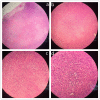Histiocytic Necrotizing Lymphadenitis Mimicking Acute Appendicitis in a Child: A Case Report
- PMID: 34604132
- PMCID: PMC8484880
- DOI: 10.3389/fped.2021.682738
Histiocytic Necrotizing Lymphadenitis Mimicking Acute Appendicitis in a Child: A Case Report
Abstract
Background: Histiocytic necrotizing lymphadenitis, also known as Kikuchi-Fujimoto disease (KFD), is a self-limiting inflammatory disease with low incidence and high misdiagnosis rate in children. Furthermore, cases where the clinical presentation resembles acute appendicitis are very rare. Case Presentation: A 14-year-old boy was misdiagnosed as acute appendicitis and received operative treatment at his early visit. He suffered from abdominal pain, vomiting, diarrhea, fever, and lymphadenitis at the ileocecal junction, which were found by B-ultrasonography examination and surgery. Lymphadenectomy, as well as appendectomy, was performed, and KFD was identified by pathological examination. The patient was transferred to our hospital for further therapy because of recurrent fever and abdominal pain after the appendectomy. His temperature became normal after methylprednisolone was administered, and no recurrence was observed till now during follow-up. Conclusions: Necrotizing lymphadenitis involving mesenteric lymph nodes may cause acute-appendicitis-like symptom; KFD should be a diagnostic consideration for mesenteric lymphadenitis.
Keywords: Kikuchi-Fujimoto disease; acute appendicitis; case report; child; histiocytic necrotizing lymphadenitis.
Copyright © 2021 Hua, Chen, Chen, Gu and Shu.
Conflict of interest statement
The authors declare that the research was conducted in the absence of any commercial or financial relationships that could be construed as a potential conflict of interest.
Figures


References
Publication types
LinkOut - more resources
Full Text Sources

